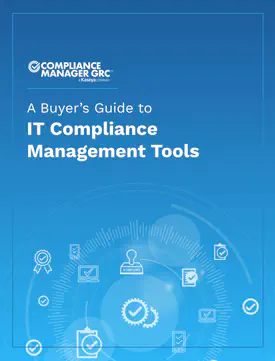Safeguarding sensitive federal information has never been more crucial. The National Institute of Standards and Technology (NIST) 800-171A provides a framework for protecting controlled unclassified information (CUI) residing in non-federal systems. As data breach incidents increase and cyberthreats become more sophisticated, complying with these standards is not just mandatory but essential for maintaining trust and security in federal processes.
Dive into our blog to see how Compliance Manager GRC by RapidFire Tools plays a significant role in embedding this standard into your organization’s routine and making compliance more manageable for your operations.
Understanding NIST 800-171A
Organizations that process or store sensitive, unclassified information on behalf of the U.S. government need to be compliant with the NIST 800-171A cybersecurity standards. This may include the Department of Defense, universities and research institutions that receive federal funds, or organizations that provide services to government agencies. It is aimed at enhancing the security posture of defense contractors and other entities that deal with CUI. The primary objective is to prevent unauthorized access to sensitive information, thus providing national security.
The NIST 800-171A checklist and best practices
Complying with NIST 800-171A requires a self-assessment. The standard contains 110 security controls along with 320 objectives that organizations need to meet to achieve compliance. Although it might seem daunting, there is a clear process to executing a NIST 800-171A assessment and achieving compliance.
The steps for conducting the assessment involve:
- Starting an assessment team with feedback from senior information security stakeholders.
- Creating an assessment plan, which will include a timeframe and objectives.
- Carrying out an internal communication campaign to spread awareness of the project.
- Listing contacts of personnel with relevant responsibilities, such as system administrators and information security specialists.
- Collecting relevant documents (existing security policies, system records and manuals, previous audit results and logs, admin guidance documents and system architecture documents).
- Assessing individual requirements in the NIST 800-171A document and recording a statement for each.
- Having a plan of action that highlights how many unmet requirements will be achieved.
- Compiling all evidence for compliance into a System Security Plan (SSP) document.
Assessing each of the objectives can be time-consuming and labor-intensive. This is where the right NIST 800-171A assessment tool, like Compliance Manager GRC, comes into play. Compliance Manager GRC simplifies the process through its structured approach that includes:
- Identifying and categorizing information that needs to be safeguarded as specified by the federal contract.
- Limiting access to CUI to only authorized users through robust authentication mechanisms.
- Implementing incident response plans to address potential security breaches quickly and efficiently.
- Regularly assessing the effectiveness of security measures and refining them as necessary.
- Training staff in their roles in securing CUI and maintaining compliance.
Overcoming common challenges
The implementation of NIST 800-171A can bring challenges that can be daunting to overcome for organizations not accustomed to such detailed compliance requirements. Let’s take a deeper look at these hurdles and how to navigate them.
Limited understanding of requirements
Most organizations struggle with the sheer complexity of NIST 800-171A. This can lead to incomplete or incorrect implementation. What’s required is detailed guidance and explanations for each requirement to ensure organizations understand the “why” and “how” behind each compliance control.
Technical constraints
Smaller organizations or businesses with limited IT resources might find it difficult to meet some of the more technical requirements of NIST 800-171A. The right NIST assessment tool helps automate many of the technical controls, such as data encryption and access controls. This reduces the need for extensive IT expertise and infrastructure adjustments.
Resistance to change
Employees and management may resist new processes that come with compliance efforts, viewing them as obstacles to productivity. With the right tool, organizations can ease this transition by seamlessly integrating with existing workflows and systems, minimizing disruptions. Moreover, the training modules and resources available with the tool can educate and engage staff on the importance of compliance.
Compliance costs
The financial investment required to meet compliance is crucial, especially for small and medium-sized businesses. The ideal way to tackle this is to leverage a NIST assessment tool that is cost-effective and offers scalable solutions, implementing necessary protections without extending the budget.
Continuous compliance maintenance
Compliance is an ongoing process. Organizations often struggle to maintain compliance amid evolving threats and changing regulations. Offering continuous monitoring and alerts is the ideal way to deal with this challenge. This ensures that organizations remain compliant over time and can quickly adapt to new requirements or threats.
Compliance Manager GRC addresses all these impediments with practical, automated solutions and continuous support. It simplifies the interpretation of compliance requirements and provides real-time insights into compliance status and security posture.
Simplifying NIST 800-171 A compliance with Compliance Manager GRC
As cyberthreats evolve, so too will the NIST 800-171A standard. One can expect future updates to focus more on advanced persistent threats, enhancements of controls around cloud storage and Internet of Things (IoT) devices, and the improvement of identity and access management (IAM) technologies. To stay ahead of these changes, you need a tool like Compliance Manager GRC to ensure you are always compliant and secure.
Compliance Manager GRC simplifies the complex NIST 800-171A compliance landscape by automating the assessment and monitoring processes. This ensures all requirements are met consistently and efficiently. Features like guided risk assessments, automated control implementations and continuous compliance tracking reduce the administrative burden related to compliance and mitigate the risk of security breaches. The tool ensures organizations maintain up-to-date security protocols that safeguard sensitive information and build trust with federal entities.
Dive deep into how Compliance Manager GRC can help your organization seamlessly navigate the complexity of NIST 800-171A compliance by scheduling a demo.
